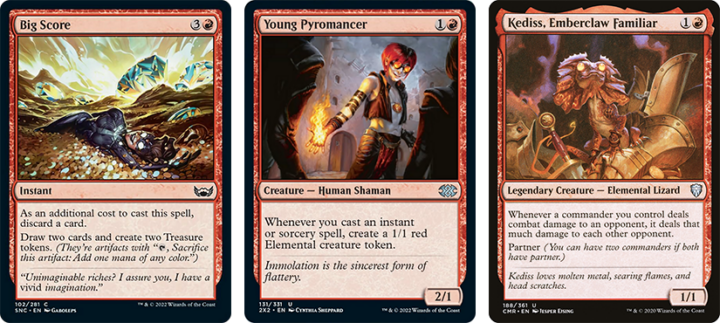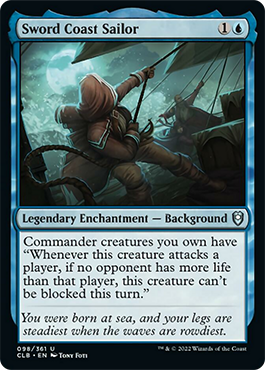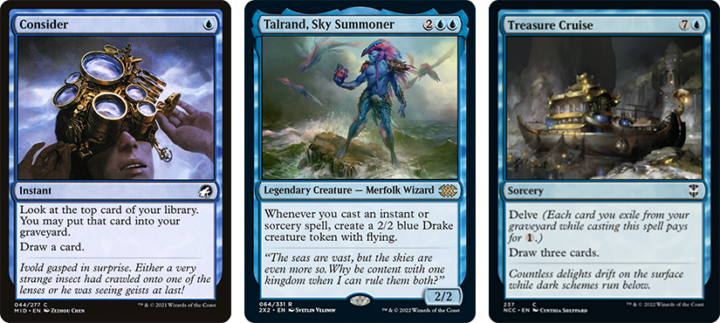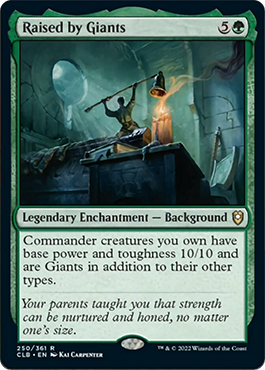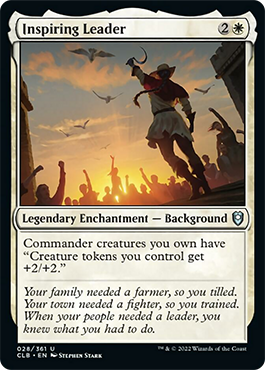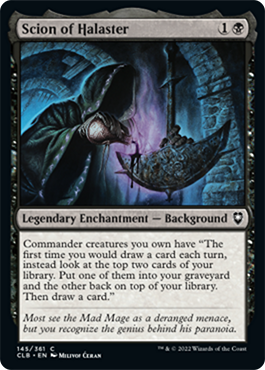Why build one Commander deck when you could build four? Backgrounds make the more accessible than ever, as Scott tries it out!
It’s nice to have a wide range of decks to play with. You can play a number of different strategies to suit the mood, and since there are so many, they’ll keep you engaged and interested for a long time. There are a few downsides though: the cost of building and protecting them can really add up, even if you’re only building a few decks. They can also be quite bulky, especially when it comes to storage and travel. There is a way to have both variety and convenience though, and it also happens to be a fantastic brewing challenge: modular decks!
Modular decks are a concept that many brewers have flirted with over the past couple of years. The idea is that you have “modules” in a deck, and you can swap them out to have different effects. The first time I saw a modular deck was when Tomer from MTGGoldfish built a “2-in-1” Kicker deck, with Hallar, the Firefletcher and Verazol, the Split Current as the commanders. I’ve since seen many different ideas for modular decks, and they’re all as interesting as they are innovative.
You could take an approach that Chris’ (Commander Mechanic) did with Ziatora, the Incinerator, where you make 15-card packages to change the deck’s theme or sub themes on a whim. You could build a power board: a 15-20 card sideboard that can slot into a deck specifically to change the power level only. You could even take two different commanders that share a color, and build a larger module for each that allows you to swap between commanders while keeping the same base theme intact. Or you can do like I did.
When Commander Legends: Battle for Baldur’s Gate came out, I was fascinated by the Backgrounds. This “Partner, but not Partner” mechanic felt like a fresh and exciting new approach to Commander, and a great way to make fun new combinations. It struck me one day that taking one legendary creature with “choose a Background” and applying different backgrounds to them is like showing how that legend’s life is impacted by their background and environment. I’m not really a Vorthos, but I loved the idea of exploring how a deck would mechanically change based on how a legendary creature was living their life. So I embarked on one of my most ambitious brews to date: to take one commander, and build four entirely different lives for them through backgrounds!
I wanted to build this as a budget deck, so I aimed to keep the price around $150. This was a real challenge, as I’m effectively building four decks for that price. This becomes a lot easier to build if money is no object, but that’s unfortunately not a reality for most of us, so I tried to keep it as limited as possible.
The Core
The first point of business is to make the core of the deck. This is the part that will remain the same no matter which module I choose to play with, so I want to make it as flexible as possible. I chose to make this part 60 cards in size; this gives me scope to form a decent core, but it means each module will be 40 cards, which is plenty to build a unique identity. But before I can get that deep on it, I have to pick a commander that really excites me.
The Commander
I chose Livaan, Cultist of Tiamat as the main commander for a number of reasons. First, “noncreature spells” is a pretty broad theme, so I have a lot of flexibility and options when it comes to choosing and building the modules. Next, it could be used to kill through commander damage with little effort, giving it another angle of attack. Finally, it’s in red. I love red.
With Livaan chosen, I need to fill the core of the deck with pieces that are flexible enough to make any version of the deck run smoothly. As I’m leaning into noncreature spells, I want to make sure that I have a decent number of them to reliably trigger Livaan’s ability. I chose to use red’s high velocity card draw, like Cathartic Reunion and Faithless Looting, as my main value pieces for this reason. They also give me another angle that I can use in building the modules: self discard. The more recent versions of this effect that also give you treasures (like Big Score) are ideal; the treasure rebate means that you still effectively pay two mana for the spell, but Livaan sees it as a 4 mana spell, giving them +4/+0!
In keeping with the noncreature theme, I added payoffs like Young Pyromancer and Kessig Flamebreather to help generate more value. Since Livaan is also going to be in every iteration of the deck, it makes sense to add pieces that push them into overdrive. Kediss, Emberclaw Familiar can help triple the output of my noncreature spells by dealing damage to each other opponent when Livaan connects in combat. Since they’re a shaman, Harmonic Prodigy seems like a no-brainer: double the triggers means double the damage!
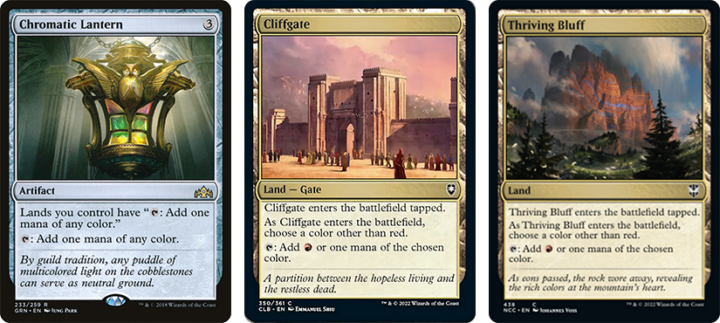
The ramp and mana base were tricky to get right, as I couldn’t add any cards that were outside of a mono red color identity, otherwise they may not be legal with certain modules. Classics like Sol Ring and Arcane Signet can fit in just fine, but the best mana rock is definitely Chromatic Lantern, to give me perfect fixing. There are also a lot more lands that can fit into a mono-color identity than I expected. Lands like Cliffgate and Thriving Bluff are perfect here, as they let me choose a second color when I play them; this means they don’t have a second color innately associated with them, so I can use them here. I settled on 21 lands for the core; this gives me roughly 14 lands in each module, to allow for basics and dual lands for good fixing.
With that foundation done, I have to add some interaction, threats, and utility. Red has plenty of good interaction, like Chaos Warp, Tibalt’s Trickery, and Wild Magic Surge, so it’s just a case of choosing favorites. Since I’m feeling the noncreature theme is honing in on instants and sorceries, I want to add threats like Charmbreaker Devils both as a recursion piece, and as a backup for Livaan. Red is surprisingly good at utility too, with copy and redirect effects being especially good. I’m adding cards like Dualcaster Mage and Wyll’s Reversal to be able to interact with the stack when I’m not running the blue module, and because they’re a lot of fun to play with!
This is the final draft of the core I settled on. It’s powerful and flexible, and could easily support a number of different archetypes. Speaking of, I need to get to work on the modules!
The Modules
Each of these modules are 40 cards, and focus on a unique theme. Some of them will be more synergistic than others, and some may be more powerful. This is a good thing, as not only will I be able to adjust the style of play, but also even the power level.
Sword Coast Sailor – Spellslinger
What if Livaan took to a life on the open seas? I’m not sure, but I love the idea of making them unblockable while I buff them with huge spells!
Blue decks that are focused on noncreature spells are some of the most well-known Spellslinger decks out there, and for good reason. You get access to cheap spells, and many ways to reward you for casting them. These will work brilliantly here, giving me a way to win through attrition if Livaan isn’t up to the task.
Cantrips like Opt and Consider are essential: they give me cheap card selection and the ability to dig for answers, and when paired with value engines like Talrand, Sky Summoner and Murmuring Mystic, they can add up to a massive board before long. Delve spells like Treasure Cruise are great here since they’ll likely cost just one or two mana, but Livaan will get an enormous power boost from them!
This feels very much a traditional spellslinger deck, but the added commander damage angle ensures that it stands out from the crowd. Speaking of standing out…
Raised By Giants – Pump Spells
If Livaan, Cultist of Tiamat was Raised by Giants, they would be a sight to behold! They would also be terrifying, since a 10/10 commander is a terrifying concept, and that’s before they get additional power boosts!
This module focuses on pushing Livaan’s power through the stratosphere as quickly as possible, using pump spells and high mana value spells to get the job done. This is easily the most aggressive module, as it wants to apply pressure early and often. It can also make combat a nightmare for opponents, since they’ll never know what tricks I might have up my sleeve.
Pump spells are the name of the game here, and Livaan’s ability will always give them a double boost. Invigorate is one of the best pump spells on rate, since it will effectively give Livaan +7/+4 for zero mana! Since I’m in green for this one, I can add a bit of extra ramp to help cast more expensive spells too. Rishkar’s Expertise synergizes so well with Livaan; when you cast it, Livaan will gain +6/+0, guaranteeing me at least seven cards and a free spell. The real closing power comes from the miracle spells. If I draw Revenge of the Hunted as the first card for the turn, I’ll be able to pay a single green mana to give Livaan a whopping +12/+6!
This build is as terrifying as it is fun. It relies much more on Livaan as a critical piece than the other modules, but it’s absolutely worth the risk for such an entertaining story!
Inspiring Leader – Tokens
Livaan may be a simple cultist, but I think they might have what it takes to be an Inspiring Leader. That, or a Boros tokens deck would be a fun approach for a module!
I think this is the module that relies on Livaan the least. That’s not necessarily a bad thing though: it’d be one of the better options if I was facing a lot of targeted removal, and the tokens can go wide and pressure opponents while Livaan goes tall, giving me multiple angles of attack.
Tokens are the name of the game here, so I need to use spells like Raise the Alarm to start going wide, all while pumping Livaan’s power. Battle Screech is particularly good, as I can essentially cast it twice for just four mana, and give Livaan +8/+0 in the process! Protecting my board is also crucial here, so cards like Make a Stand, Unbreakable Formation, and Rootborn Defenses are absolutely necessary. While I may have access to an anthem effect in the command zone, it’s always good to have redundant ways to close the game. Rally the Peasants is a fantastic way to do so quickly, while also being excellent discard fodder for the core’s card draw effects.
There aren’t quite as many token generators as you’d typically see in a dedicated tokens deck, but it still does a great job at being a formidable swarm deck in most situations. I never really felt drawn to token decks personally, so I didn’t want to dedicate a whole 100 cards to making one. However, I was more than happy with this 40-card module stepping up to the job!
Scion of Halaster – Reanimator
Can one be a Cultist of Tiamat and a Scion of Halaster at the same time? I’m not sure, but Livaan makes for a great reanimator commander!
Scion of Halaster works exceptionally well with the rummaging card draw in the core of the deck, allowing me to fill the graveyard in record time. I’m looking to bin large creatures early, then pull them back out quickly to pressure opponents and grind them out.
- What this module wants to do
- Make use of the self discard effects
- Bin & reanimate threats early on to pressure opponents
- Grind out in the mid game through sacrifice and reanimation
- How it wants to win
- Pressure & attrition
- Enormous threats
Every reanimator deck needs big creatures, and black has plenty of great choices. I want to make sure there are a number of different options that will suit different situations; Pathrazer of Ulamog is a great way to obliterate board states while applying pressure, Sepulchral Primordial can build out a big board, and Burning-Rune Demon can search for any of the many options. Reanimation spells are aplenty, with Victimize, Dread Return, and Zombify all being great choices. Exhume is particularly fun to follow a turn one Faithless Looting, and can make for a tense and interesting situation later in the game. To make sure I have access to more creatures to reanimate, cards like Village Rites and Deadly Dispute will put them back in the bin for me. I can even bring them back immediately with Supernatural Stamina if needed for additional grind value. This brutal level of constant attrition is sure to turn even the hardiest opponents into dust eventually!
Reanimator is always a blast to play, and this is no different. It’s not very reliant on Livaan, but it makes excellent use of the card draw suite in the core to set up reanimation targets. This is probably the module that’s most likely to stay steadfast in a long game and never run out of steam, which would be ideal for when everyone’s looking to settle in for a two hour game!
This was a gargantuan undertaking, at least compared to brewing a regular deck. It was incredibly rewarding though; I feel like I learned to cross examine cards better, discover new and different applications for cards, and my overall deck building skills got a little bit tighter. If you’re looking for a brewing challenge to really test and flex your brewing skills, this is the one for you. If you like the idea but find this to be a bit intimidating, then you can try some of the smaller scale ideas I mentioned at the start. These projects feel fulfilling, no matter the scale!
Modular decks are slowly becoming more popular, and it’s easy to see why. They’re a lot of fun to build, they’re always a great conversation starter, and they never get boring. If you have a modular deck, or you have ideas for other ways to build a modular deck, I’d love to hear about it on Twitter! Happy brewing!

Scott is an Irish content creator and the Head of Budget Magic for the Izzet League. He focuses on affordable decks in Pioneer, Modern, and Pauper, particularly ones that stray from the mainstream. When he’s not writing about his favorite decks, he can be found talking incessantly about them on Twitter and on The Budget Magic Cast.



